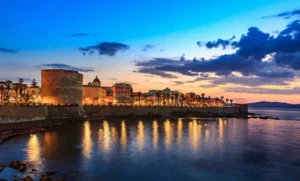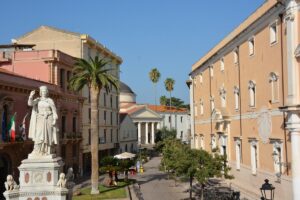Discover the Fresh and Nutritious Vegetables of Sardinia
Sardinia, this idyllic Italian island nestled in the heart of the Mediterranean Sea, is a heaven-on-earth for food lovers, particularly those with a penchant for fresh, nutritious, and flavor-packed vegetables. Empowered by the richness of the Sardinian soil and the timeless farming traditions passed down through generations, the “Vegetables of Sardinia” form the backbone of a vibrant, sustainable, and health-conscious food culture that truly sets Sardinia apart.

The Bounty of Sardinia
Talk about vegetables in Sardinia, and the conversation instantly transports you to lush landscapes cultivated with a multitude of vibrant greens, be it the sprawling fields of artichokes, patchwork quilts of vibrant tomatoes, or the hillsides adorned with fava beans. Each bite into these fresh goodies reveals an unadulterated taste that only fertile Sardinian land could produce.
The Soil: Where Sardinia’s Vegetable Magic Begins
To truly appreciate the variety and vibrancy of Sardinian vegetables, we need to start from the ground up. Literally! The Sardinian soil, enriched by its unique Mediterranean climate, bestows a distinct character to the produce that grows there.
Think of the most flavourful tomato you’ve ever bitten into. Now imagine that flavour, amplified. That’s what Sardinian soil does—it boosts flavours, enriches , and nurtures the growth of an abundant variety of vegetables.

The Bounty of Sardinia’s Vegetable Gardens
Picture this: lush gardens dotted with ripening tomatoes, flourishing zucchini plants, and rows of vibrant greens like spinach and chard. Imagine neatly lined fields of artichokes, their thorny crowns basking under the Mediterranean sun. This is not just a scenery—it’s a common sight when you traverse the agricultural landscapes of Sardinia.
One vegetable that stands out in this vibrant parade is the Sardinian artichoke, or carciofo spinoso di Sardegna. A true gem in the array of “Vegetables in Sardinia”, the local artichoke is so unique and tasty that it’s protected by an IGP status (Protected Geographical Indication). Sardinians prepare it in numerous ways, showcasing the versatility of this spiky wonder.
And then, of course, there are the tomatoes. I’m not talking about your everyday, run-of-the-mill tomatoes. Sardinia is home to pomodoro di Pula, a rich, sweet, and slightly salty tomato that’s a staple in local cuisine. It forms the base for many Sardinian dishes, adding that signature Mediterranean tang that we all love.

The Unique Sardinian Spin on Vegetables
What sets Sardinia apart isn’t just the variety of vegetables that thrive on the island—it’s also how they’re used in local cuisine. Take the humble fava bean for example. While most of us might think of it as just another legume, in Sardinia, it’s transformed into fave e cicorie, a traditional dish paired with wild chicory.
Then there’s the iconic panada, a savoury pie filled with a mix of lamb, potatoes, and artichokes. It showcases how Sardinians skilfully integrate vegetables into dishes to create a harmony of flavours.

Flavours Unparalleled: A Look at Key Sardinian Vegetables
Artichokes from Uri
Uri, a quaint town located in northwestern Sardinia, boasts an ideal climate for artichoke cultivation. Regularly used in traditional dishes, these artichokes are rich in fiber and antioxidants, reducing the risk of many diseases.
Artichoke Festival
One of the most significant events in the entire region that draws in countless tourists and visitors each year is the summer Artichoke Festival. Held in the charming village of Uri, this festival celebrates the spiny Sardinian artichoke, a culinary treasure known for its delicious and succulent taste. The festival is the perfect occasion to relish this fantastic product with its prestigious PDO denomination.
At the Uri Artichoke Festival, you’ll have the opportunity to savor a wide array of delightful Sardinian artichoke dishes, prepared according to traditional recipes and innovative interpretations. However, the festivities don’t stop with gastronomy alone. The event’s calendar is packed with cultural and folklore activities, including songs, dances, musical performances, and craft exhibitions, providing an immersive experience into the local traditions.

This captivating festival traces its origins back to 1990, aiming to stimulate agricultural development in the region and create a unique connection between tradition, gastronomy, history, and tourism. Today, it is an integral part of the ‘Salude & Trigu’ program by the Sassari Chamber of Commerce, designed to offer tourists and curious travellers an authentic glimpse into the folklore and traditions of northern Sardinia. It’s an initiative that lets visitors relish the essence of these significant cultural events, immersing themselves in the sights, sounds, and flavours of the territory.
The Uri Artichoke Festival is a summer highlight and is typically held in the middle of August. In 2023, the dates are set for August 4th and 5th. For those intrigued by the celebration of culinary excellence and rich cultural heritage, this festival is an absolute must-attend.
Tomatoes of San Sperate
San Sperate tomatoes have been celebrated for their intense flavour, juicy texture, and nutritional benefits. Their rich lycopene content, an antioxidant, is known to provide several health benefits, from skin protection to prevention of heart diseases.
Fava Beans from Gavoi
High in protein and low in fat, the fava beans from Gavoi epitomize the nutritious profile of Sardinian vegetables. Traditionally made into a puree and served with local bread, this humble legume famously symbolizes Sardinian longevity.
Farm-to-Table Culture: Backbone of Sardinian Diet
Linking this varied array of vegetables is the deeply ingrained farm-to-table culture of Sardinia. Seasonal eating is not a fad here, but a way of life. This tradition highlights the society’s close relationship with the land, significantly contributing to the renowned Sardinian longevity.
Sow-Bake-Reap: Traditional Sardinian Recipes
One of the purest pleasures of knowing “Vegetables of Sardinia” lies in savouring them in traditional recipes, simple yet rich in flavours. From “Sa Fregula cun cocciula,” a tomato-based soup with Fregula (a type of Sardinian pasta) to “Aligusta,” a classic artichoke dish, Sardinian cuisine tells a story of simplicity, nutritional richness, and depths of flavor intertwined in every morsel.
Fregula cun Cocciula (Sardinian Fregola with Clams)
- ¼ cup dry white wine (such as Vermentino)
- 2 pounds littleneck clams (about 30 clams), rinsed and scrubbed
- 4 cups fish stock, plus up to 1 1/2 cups stock if needed, divided
- 1 ¼ cups thinly sliced fennel bulb (from 1 small fennel head), fronds reserved for garnish
- 5 garlic cloves, thinly sliced (about 1 1/2 tablespoons)
- 1 tablespoon olive oil
- 2 tablespoons tomato paste
- 1 teaspoon crushed red pepper
- 2 teaspoons kosher salt
- 20 saffron threads (about 1/4 teaspoon)
- 1 ⅓ cups uncooked fregola
- 2 teaspoons grated lemon zest, plus 3 tablespoons fresh lemon juice (from 1 lemon), divided
- 1 tablespoon chopped fresh flat-leaf parsley
- In a large saucepan over medium heat, simmer the wine.
- Add the clams, cover the saucepan, and let them cook undisturbed until the shells open (6 to 8 minutes). Discard any unopened clams.
- Carefully strain the clam mixture through a fine wire-mesh strainer lined with cheesecloth into a heatproof bowl. Keep the opened clams and clam cooking liquid (liquor) separate.
- Measure the clam liquor and add fish stock as needed to make 2 cups of liquid. Set it aside.
- Clean the saucepan and return it to medium-high heat.
- Add sliced fennel, garlic, and oil. Cook and stir until the fennel lightly browns (4 to 6 minutes).
- Stir in tomato paste and crushed red pepper, cooking constantly until the tomato paste darkens slightly (about 1 minute).
- Pour in the reserved 2 cups of clam liquor, scraping the browned bits from the bottom of the pan.
- Add the remaining 4 cups of fish stock, salt, and saffron. Bring it to a simmer over medium-high heat.
- Stir in fregola and cook, occasionally stirring, until it becomes al dente (14 to 16 minutes).
- Remove from heat and stir in lemon juice and clams.
- Garnish with parsley, fennel fronds, and lemon zest. Enjoy!
The Future of Vegetables in Sardinia
From an analytical perspective, the emphasis on “Vegetables in Sardinia” plays a crucial role in the island’s sustainable future. By nurturing local produce, Sardinians are maintaining their cultural heritage, supporting local economies, and promoting sustainable farming practices.
Whether you’re a culinary enthusiast, a health-conscious eater, or simply an admirer of nature’s bounty, the vibrant world of vegetables in Sardinia has something to offer you. And who knows? Maybe it’ll inspire you to add a Sardinian twist to your kitchen garden or your next meal.
Sardinia’s robust and diverse vegetable culture is an undeniable testament to the island’s rich soil, perfect climate, and the culinary artistry of its people. It’s a culture that respects nature, celebrates flavour, and embraces sustainability.

Final Thoughts: Savour the Best of Sardinian Bounty
Enjoying fresh and nutritious “Vegetables of Sardinia” isn’t merely about delighting your taste buds. It’s about experiencing a culture that values sustainability, cherishes its land, celebrates seasonal eating, and ultimately leads to a healthy, long life.
In this fast-paced modern world, the narrative of Sardinian vegetables offers an unmissable lesson about slowing down, eating right, and savoring the magic that nature offers, served fresh from the fertile Sardinian soil, straight onto our plates.



